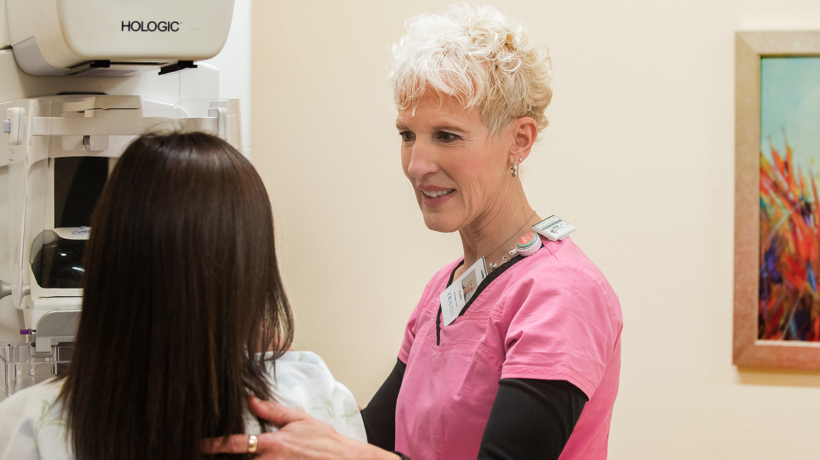Mammography

Digital breast tomosynthesis (tomo), more commonly known as 3D mammography, is used in combination with 2D digital mammography. An x-ray arm sweeps over the breast, taking multiple images in just seconds. A computer then produces a 3D image of your breast tissue in one millimeter layers. This allows our radiologists to examine the tissue one thin layer at a time, in a sense traveling through the structure of the breast like pages of a book. Fine details are more visible and are less likely to be hidden by overlapping tissue.
A screening mammogram is a routine exam for women who have no sign or symptoms of breast disease. Women do not need a written referral from a health care provider for this exam. However, your health care provider will be sent a final report detailing your exam results.
Screening mammography is recommended every year for women, beginning at age 40. Mammography plays a central part in early detection of breast cancer because it can often detect potential problems before they can be felt. This early detection greatly increases treatment options and the likelihood of a successful recovery.
A diagnostic mammogram is used to evaluate breast problems or concerns—such as a breast mass, palpable lump, nipple discharge, unusual breast pain, or skin changes—and does require a referral from your health care provider. Diagnostic mammograms may also be used to investigate potential abnormalities discovered on a screening mammogram.
Take a look at the difference between our screening and diagnostic mammograms here.
-
Mammograms at Diagnostic Imaging Northwest
-
When you have a mammogram at Diagnostic Imaging Northwest you can expect skilled, personal care every step of the way. Before your exam, a mammography technologist will review your medical history and answer any questions you may have. Your comfort during the exam is our top priority, so a female technologist will be available throughout your exam.
Please inform your technologist if:
- you are nursing
- you think you could be, or are pregnant
- you have breast implants
- had recent breast surgery or biopsy
-
How to Prepare for a Mammogram
-
Prior to your exam, our staff will inform you of any preparation instructions and your appointment check-in time. Please provide Diagnostic Imaging Northwest with the location of any previous mammograms, or films/images taken at a different location.
Your exam will take place in a private environment just for women. Please wear a comfortable, two-piece outfit as you will be asked to remove your top. A gown and a locker is provided. Please refrain from wearing any powder, deodorant, and perfume on your underarms and breasts. These products can interfere with accurate visualization of your breast tissue. Towelettes are provided to clean this area and deodorant is available to reapply after your exam.
-
What to Expect During a Screening Mammogram
-
Please plan to be in our clinic for 30 minutes to complete your appointment. A screening mammogram consists of low-dose x-ray views of each breast—from above and from the side. Images are obtained by compressing your breast between two plastic plates. Adequate compression is essential to detect subtle abnormalities, but each compression lasts for about 30 seconds. Please inform your technologist if you experience significant discomfort or pain.
-
What to Expect During a Diagnostic Mammogram
-
Plan to be in our clinic for an hour to complete your appointment. A diagnostic mammogram is similar to a screening mammogram, and is performed on the same type of machine. However, there are more specialized views and images. These images are immediately reviewed by the radiologist. In some circumstances, your mammogram may be followed by a breast ultrasound exam.
-
Mammogram Results
-
A board-certified radiologist specializing in breast imaging will interpret images from your exam. A final report of your exam will be forwarded within 24-48 hours to your referring health care provider. The images are digitally archived and easily available to you or your health care provider as needed.
Results of your screening mammogram will be mailed to you. Should your screening mammogram results recommend further imaging, we will contact you. Learning of an abnormal result can make anyone anxious. However, try not to panic. A vast majority of breast abnormalities are benign (not cancer). Nevertheless, serious attention is paid to every abnormality and we will assist in getting you the level of care needed.
Results from your diagnostic mammogram, as well as any recommendations, will be shared before you leave your appointment.
